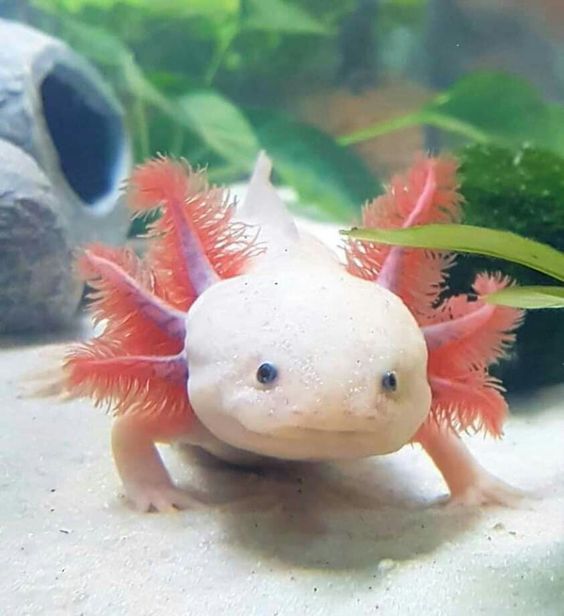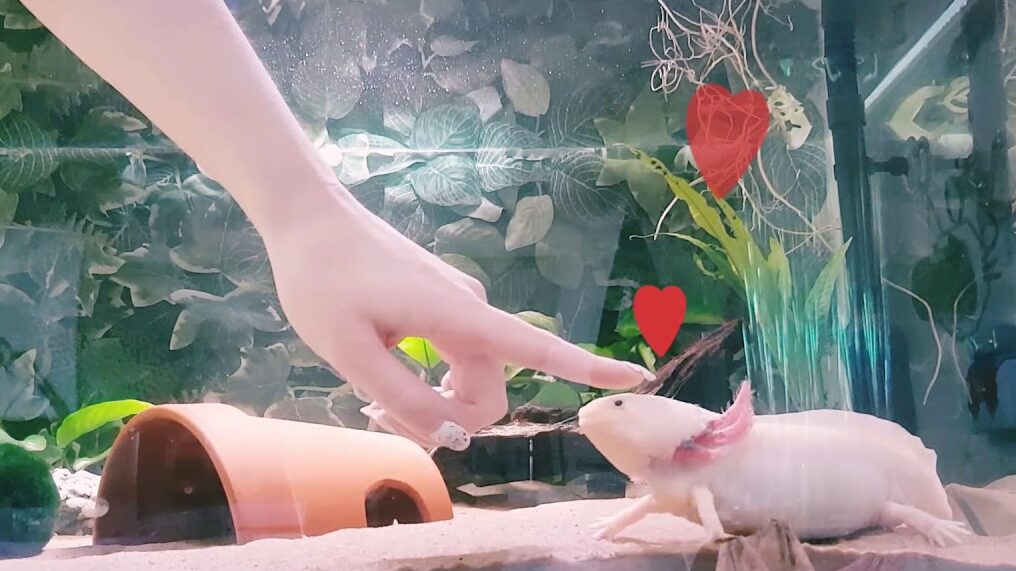
Axolotls, with their distinctive fringed gills and aquatic lifestyle, thrive when their habitat mirrors their natural environment. Central to their well-being is the regulation of water temperature. Achieving and maintaining optimal conditions is not merely about providing warmth; it’s a delicate balance that ensures these unique creatures flourish. From mimicking their native habitats to employing advanced thermoregulation devices, this guide delves into the intricacies of sustaining an ideal environment for axolotls. “Axolotl Temperature”
Is an Increase or Decrease of Temperature Affect an Axolotl’s Life?
Sudden temperature changes can significantly impact an axolotl’s well-being. Whether you have a mosaic axolotl, Piebald Axolotl, or any other variety, all axolotls require a stable environment. A rapid temperature increase can lead to stress, while a decrease can affect their metabolism and immune system. Maintaining the correct temperature is crucial for the long, healthy life of these unique aquatic creatures.
Understanding Axolotl Sensitivity to Temperature Changes
Axolotls, being ectothermic, rely on external sources to regulate their body temperature. Slight temperature shifts can significantly impact their well-being. Understanding the nuances of axolotl sensitivity involves exploring the factors influencing them, such as age and health. Signs of discomfort, like changes in behavior and appetite, serve as vital indicators. By comprehending their responsiveness to temperature changes, caretakers can proactively create stable conditions, fostering a thriving axolotl community.
Impact of Temperature Fluctuations on Axolotl Health
Temperature fluctuations pose distinct challenges to axolotl health. Stress-related issues, stemming from abrupt changes, can compromise their immune system. Respiratory challenges, another consequence, highlight the intricate link between water temperature and oxygen levels. This section explores these health implications, emphasizing the importance of a stable environment. By recognizing and mitigating the impact of temperature variations, axolotl enthusiasts can ensure the longevity and vitality of these captivating aquatic beings.
What is the Ideal Temperature for an Axolotl?
Understanding the ideal temperature for axolotls is fundamental to their well-being. Typically, these fascinating creatures thrive in a temperature range of 16-18 degrees Celsius (60-64 degrees Fahrenheit). This optimal range closely aligns with the conditions of their natural habitat in the cool, high-altitude lakes of Mexico. Maintaining this temperature sweet spot is crucial for axolotls to exhibit their natural behaviors, stay healthy, and avoid stress-related issues. As we explore further, it becomes evident that replicating their native environment is key to providing the ideal temperature for axolotls.
Axolotl Natural Habitat and Temperature Preferences
Axolotls hail from the lake complex of Xochimilco in Mexico, where the water is cool and well-oxygenated. Understanding their natural habitat is essential for creating a suitable environment in captivity. The cool waters of their origin influence their temperature preferences. This section delves into the specifics of the axolotl’s natural habitat, emphasizing the need to mimic these conditions. From water quality to hiding spots, aligning the tank with their native surroundings ensures that axolotls feel comfortable and exhibit natural behaviors.
Maintaining Consistent Ideal Temperature
Consistency is key when it comes to maintaining the ideal temperature for axolotls. Fluctuations, even within the recommended range, can cause stress and health issues. This section explores practical strategies to ensure temperature stability. From using high-quality aquarium heaters with thermostats to monitoring temperatures regularly, caretakers can create an environment where axolotls thrive. Attention to detail in maintaining a consistent temperature not only promotes the well-being of these captivating creatures but also enhances their overall quality of life in captivity.
How to Set the Temperature When the Outside Temperature is Cold?
Setting the right temperature for axolotl tanks during chilly weather involves a thoughtful approach. Cold temperatures can affect the well-being of axolotls, making it essential for caretakers to take proactive measures. Utilizing reliable heating devices and insulation techniques is crucial in maintaining a stable environment. This section provides insights into the steps required to ensure that axolotls remain comfortable and healthy, even when the external temperatures drop.
Maintaining a consistent temperature is vital for axolotls, especially during cold weather. “Do Axolotls Change Color” is a common question among axolotl enthusiasts. When outside temperatures drop, ensure your tank has an efficient heater and monitor it regularly. Providing the Best Foods for Axolotl and maintaining a stable, warmer environment helps them thrive during colder periods, promoting their well-being.
Cold Weather Precautions for Axolotl Tanks
As winter approaches, it’s time to implement cold weather precautions to safeguard the axolotl habitat. Insulation becomes a key strategy, involving methods such as using tank wraps and insulating materials to minimize heat loss. Additionally, selecting appropriate heating devices, like submersible aquarium heaters, is vital to counteract the effects of cold weather. This section explores these precautions in detail, offering a comprehensive guide for axolotl enthusiasts to create a winter-ready environment.
Monitoring and Adjusting Temperature in Cold Weather
Monitoring and adjusting temperature in cold weather is a dynamic process that requires attention to detail. Temperature controllers prove invaluable in ensuring that the tank remains within the ideal range. This section discusses the importance of these controllers, offering tips on their effective use. Moreover, emergency measures for extreme cold events are outlined to empower caretakers with the knowledge needed to act swiftly and decisively. By staying vigilant and proactive, axolotl enthusiasts can navigate the challenges posed by cold weather and provide a safe haven for their aquatic companions.
How to Set the Temperature When the Outside Temperature is Hot?

Maintaining an optimal environment for axolotls in the face of hot weather involves strategic temperature management. High temperatures can pose risks to axolotl health, making it imperative to implement effective cooling strategies. This section explores the techniques and considerations involved in setting the right temperature during hot weather, ensuring that axolotls remain comfortable and thrive in their aquatic habitats.
Cooling Strategies for Axolotl Tanks
As the mercury rises, axolotl tanks require cooling strategies to prevent overheating. Implementing these strategies involves a multi-faceted approach, including the use of fans, ice packs, and even adjusting lighting schedules. Exploring the benefits of each cooling method, this section provides insights into how caretakers can maintain a stable and comfortable temperature for their axolotls during hot weather conditions. By incorporating these cooling strategies, enthusiasts can create an environment that mirrors the optimal conditions for axolotls.
Avoiding Overheating Issues
The specter of overheating looms large in hot weather, and understanding the signs and preventive measures is crucial. This section delves into the potential issues associated with overheating, such as increased stress levels, reduced oxygen availability, and behavioral changes in axolotls. Moreover, it offers practical tips on avoiding overheating, including maintaining adequate aeration, providing shaded areas, and adjusting the water temperature gradually. By proactively addressing the challenges posed by hot weather, caretakers can ensure the well-being and longevity of their axolotl companions, fostering a thriving aquatic ecosystem.
FAQs
Q: Can Axolotls tolerate temperature changes well?
A: Axolotls are sensitive to temperature changes, and sudden fluctuations can lead to stress and health issues.
Q: What is the ideal temperature range for axolotls?
A: The ideal temperature for axolotls typically falls between 16-18 degrees Celsius (60-64 degrees Fahrenheit).
Q: How do I heat the tank when the outside temperature is cold?
A: Insulate the tank, use a reliable heating device, and employ a temperature controller for precise adjustments.
Q: Can axolotls withstand hot weather?
A: Axolotls can struggle in higher temperatures; implement cooling techniques and monitor water temperature consistently.
Q: What are the signs of stress in axolotls due to temperature changes?
A: Stress signs include lethargy, erratic swimming, loss of appetite, and changes in skin color.
Q: Should I use a heater during the summer months?
A: In warmer months, focus on cooling methods rather than heating; avoid overheating the tank.
Q: Can I use a regular aquarium heater for axolotls?
A: Yes, but it’s crucial to choose a heater with a thermostat to maintain a stable temperature range.
Q: How do I address overheating issues in the tank?
A: Implement cooling methods such as fans, ice packs, or placing the tank in a cooler room.
Q: Should I acclimate my axolotl to temperature changes gradually?
A: Yes, gradual acclimation helps minimize stress; make adjustments slowly over several days.
Q: Can axolotls survive without a heater in a cold climate?
A: While axolotls can endure cooler temperatures, it’s advisable to use a heater to maintain the ideal range and prevent health issues.
Conclusion
In the intricate dance of maintaining optimal conditions for axolotls, temperature emerges as a central player. This guide has journeyed through the nuanced realm of axolotl care, offering insights into the delicate balance required to sustain these captivating aquatic beings. Whether navigating the challenges of temperature fluctuations, crafting the ideal temperature range, or implementing strategies for both cold and hot weather, the well-being of axolotls hinges on the commitment of their caretakers.
Understanding the ideal temperature range for axolotls is not merely about numerical values; it’s about comprehending the essence of their natural habitat in the cool lakes of Mexico. By mimicking these conditions, enthusiasts create an environment where axolotls can express their natural behaviors and thrive. Temperature, as it turns out, is more than a number on a thermometer; it’s the key to unlocking the vitality and longevity of these unique creatures.
With 3 years of devoted companionship alongside my aquatic friend, Bob, I’ve gained profound insights into the captivating world of fishkeeping. From understanding behavior to ensuring optimal health, my journey with Bob has enriched my expertise in all things aquatic.




Pingback: Safe Water for Axolotl: Finding the Best Water Type - Fish Hue